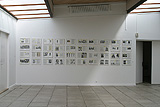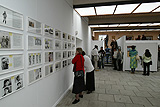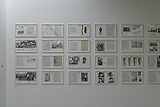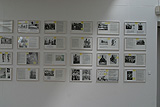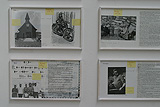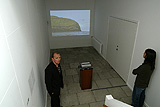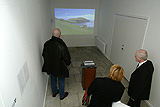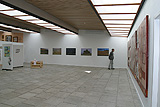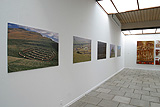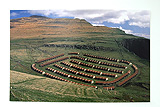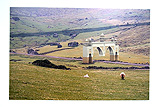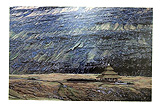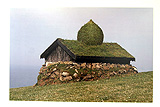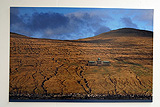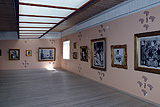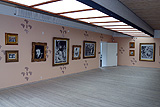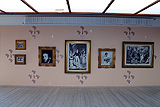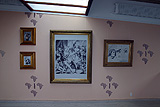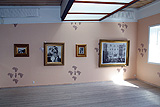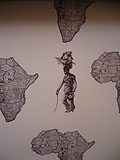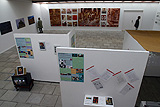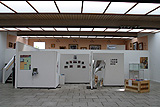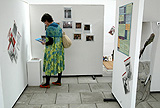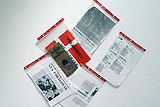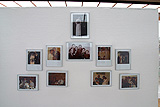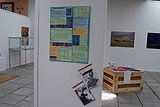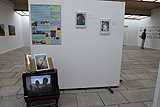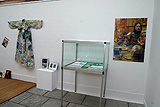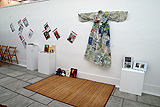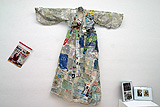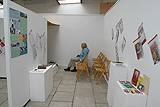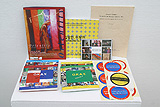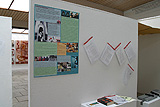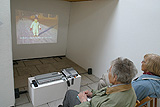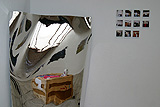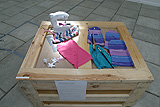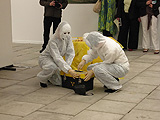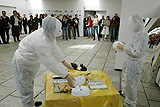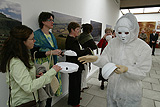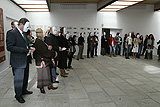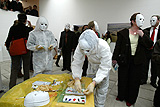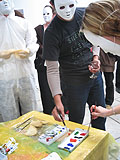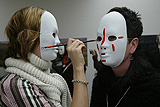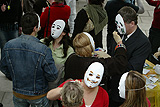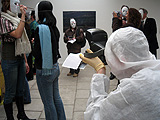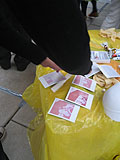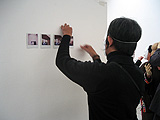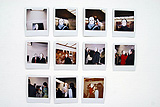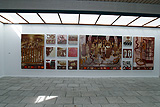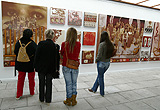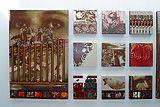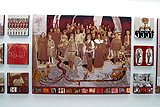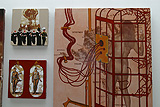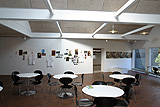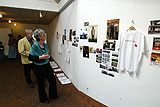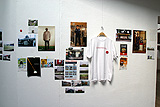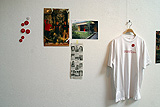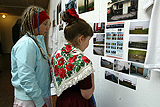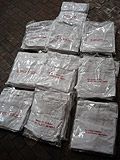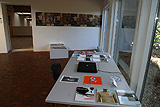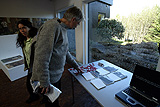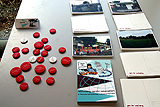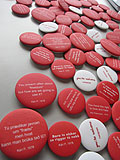
Living (in) the Postcolonial
The Faroe Islands Art Museum, Tórshavn
May 12 – June 4, 2006
Presented both in the Temporary Exhibitions Gallery and in the Museum Lobby, this exhibition sought to locate and analyze impacts of imperial dynamics on our bodies and minds. Through careful re-readings of colonial history and present-day lives, it addressed how we internalize ideas of difference and normality, and examined how individuals and communities use language and performance to come up with viable strategies for understanding and resisting imperialism in its different guises.
The exhibition was accompanied by the film program Silver Screen Resistance.
Participating Artists
Pia Arke (Greenland/Denmark)
Nadiah Bamadhaj (Malaysia/Indonesia)
Godfried Donkor (Ghana/United Kingdom)
Jane Jin Kaisen & Tobias Hübinette (South Korea/Denmark & South Korea/Sweden)
Rannvá Holm Mortensen (The Faroe Islands)
Ruangrupa (Indonesia)
Click polar bear to see video tour of the exhibition (6:46 min.)
Pia Arke was a visual artist, who worked with photography and text primarily. She graduated from the Royal Danish Academy of Fine Arts in Copenhagen in 1993 and held two additional degrees from that institution: a Cand.Phil. in Art Theory from the Department of Art Theory and a Multimedia Design degree from the School of Media Arts. Born in Greenland by a Greenlandic mother and a Danish father, most of her work deals with her Greenlandic background and the history of Greenland. Arke exhibited in a large number of contexts and completed several public art commissions for the Danish Polar Center, the Ministry of Defense, and the Environmental Investigations of Denmark, among others. Arke was the recipient of the 1999 award from the Danish Arts Foundation and in 2000, she received a 3-year work grant from the Danish Arts Foundation. [Tone Olaf Nielsen]
Pia Arke participated in Act 3 with the photo installation “Dummy” (1993), the original score for her photographic book Scoresbysundhistorier. Fotografier, kolonisering og kortlægning (Scoresbysund Stories: Photographs, Colonization, Mapping) (Borgens Forlag, 2003). In art critic Mette Sandbye’s words, “Scorebysundhistorier was the culmination of several years of artistic work and cultural-historical research on the village, where many of her relatives still live today. More than half of the book consists of text, and most of the book’s photographs are found in archives, especially photographs taken by Danish colonizers. Since photography as a medium is bound to the idea of taking into possession and of conquering, the history of photography and the history of colonialism as such are closely connected.
Scorebysund with its 600 inhabitants is located on the rough and almost uninhabited North Eastern coast of Greenland. The closest neighbor is the small military unit, Daneborg, located 400 km to the North, whereas the closest ‘city’ is Angmagssalik, which has 1,700 inhabitants and is located 1,000 km to the South. In the 1920s, the Danes fought the Norwegians on the right to North Eastern Greenland. As an important initiative in this territorial war, ten Greenlandic sealer families from Angmagssalik were in 1925 invited to settle in Scorebysund with promise of a better life. Pia Arke’s mother’s parents were among them and her mother was thus born and raised in the village. One day, Pia Arke came across an article on Scorebysund in a provincial newspaper with the title ‘Close the village without a future!’ It is information on and experiences from this village without a past and without a future that the artist brings to light in her book. The book is composed as a kind of collage of archival photographs, quotations from all sorts of (sometimes quite curious and at times almost hair-raising) primary sources, the author’s reflections, and information from the large number of interviews she conducted (for instance, in the village’s residential home where she asks the elderly residents to identify and tell about the many unnamed Greenlanders in the Danes’ photographs.” [Excerpt from text written by Mette Sandbye for the book Manual til dansk samtidskunst by Lisbeth Bonde & Mette Sandbye, forthcoming at Gyldendal, autumn 2006]
Pia Arke, Installation view of “Dummy” (1993). Extract of original score from the photographic book Scoresbysundhistorier: Fotografier, kolonisering og kortlægning (Scoresbysund Stories: Photographs, Colonization, Mapping), 2003. 49 x mixed media on paper collages (framed), dimensions variable. Photo: © Allan Broekie. Courtesy of the artist
Nadiah Bamadhaj was born in Petaling Jaya, West Malaysia in 1968. Trained as a sculptor, she now produces installations of drawings, video, and digital images. She has worked in non-government organizations on HIV/AIDS prevention, human rights advocacy, and more recently lectured at the Center for Advanced Design in Kuala Lumpur. She is author of Aksi Write (1997), a work of non-fiction on Indonesia and East Timor, co-written with her late brother. In 2000, she began full-time art practice, and was awarded the Nippon Foundation’s Asian Public Intellectual Fellowship in 2002, choosing to spend her yearlong fellowship period in Yogyakarta, Indonesia, where she currently lives. Her recent artwork looks at architecture as historical documents and carriers of memory, which is the topic of her Ph.D. research that begins in 2006. [Nadiah Bamadhaj]
For Act 3, Nadiah Bamadhaj contributed with a new video installation titled “Beyond Recognition” and a new digital print series titled “I bestow this upon you.” Both were produced specifically for Rethinking Nordic Colonialism in 2006. In Bamadhaj’s own words, “The project introduces elements of Malaysian and Indonesian architecture and literature into the Faroese landscape. My selection of architecture and literature is based on how in an attempt to embark from the elements of European colonization of the previous centuries; it inadvertently mirrors the grandeur and the social and symbolic alienation of those colonial structures. Ironically, this renders it both incongruous to its surroundings and a form of colonization in its own right.
I push this idea of ‘continued colonialism’ by incorporating these forms and texts into the Faroese landscape. The incongruity of the architectural forms and written text in the Faroese landscape acts as a metaphor for how the forms are perceived by me in their original state. And the imagined political colonization of the Faroese by Malaysia and/or Indonesia is an attempt to reflect how I perceive the mechanizations of government in my own national and residential experience. Postcolonial departures are perceived as a continued colonization in different form, and – in this case – different spaces.” [Nadiah Bamadhaj]
To view “Beyond Recognition” (12:27 min.), click polar bear
To view wall text from “Beyond Recognition,” click ![]() here.
here.
Nadiah Bamadhaj, Installation view of “Beyond Recognition” (2006). Digital video, 12:36 min. Special thanks to: Kuratorisk Aktion, Frantisek Staud, Heru Prasetyo, and NIFCA, Nordic Institute for Contemporary Art. Photo: © Allan Broekie. Courtesy of the artist
Nadiah Bamadhaj, Installation view of “I bestow this upon you” (2006). 5 x digital prints, 75 x 115 cm each. Special thanks to: Kuratorisk Aktion, Frantisek Staud, Heru Prasetyo, and NIFCA, Nordic Institute for Contemporary Art. Photo: © Allan Broekie. Courtesy of the artist
Nadiah Bamadhaj, Details of “I bestow this upon you” (2006). Photo: © Allan Broekie. Courtesy of the artist
Godfried Donkor was born in Kumasi in Ghana. He attended Central St. Martins’ College of Art and Design in London (1989), and pursued postgraduate work in Barcelona (1991). He holds a MA in African Art History from the School of Oriental and African Studies (SOAS), University of London (1996). His visual art practice incorporates the mediums of painting, printmaking, collages, photography, and more recently film/performance. He has been in the international art circuit since 1996 and has participated in residency programs in a number of key spaces in Africa, Europe, the US, and the Caribbean. These are also the spaces that inform and create visual material for his work. Using memory, history, and the notion of aesthetics as a source of creative visual references, his work is often noted to allude to the experience of “déjà-vu.”
Selected group exhibitions include: Pin Up (Tate Modern, London, 2004), Collection of the Spanish Sports Council, Ses Voltes (Palma de Mallorca, 2005), We Two Together: GHANA.NIGERIA: OLADAPO & GODFRIED DONKOR (National Theatre, Accra, Ghana, 2004), Bling Bling (London Print Studio, London, 2004), Copy it, steal it, share it (Borusan Art Gallery, Istanbul Biennale, 2003), BIDA, Biennale of Sports and Art (Salamanca, Spain, 2003), A Fiction of Authenticity: Contemporary Africa Abroad (Contemporary Art Museum, St. Louis, 2003), 1st Flag (Casino, Luxembourg, 2003), Transferts (La Palais Des Beaux Artes, Brussels, 2003), Body Power/Power Play (Wurttenbergische Kunstverein, Stuttgart, 2002), Populated (IASPIS Gallery, Stockholm, 2002), Bartimeus Prize Exhibition (National Theatre, Ghana, 2001), Sports Cult (Apex Art Curatorial Program, New York, 2001), Authentic/Excentric (African Pavilion, Venice Biennale, 2001), Africa Today: The Artist and the City (Barcelona, 2001), The 7th Havana Biennale (Havana, Cuba, 2000), World Trade (Roebling Hall Gallery, New York, 2000), Big River – International Artists’ Exhibition (Trinidad & Tobago, 1999), Routes, Five Artists (Brunei Gallery, London, 1999), Cinco Continentes y uno Ciudad Salon Exhibition (Mexico City, Mexico, 1998), Dak’ Art 98 (Dakar, Senegal, 1998).
Selected solo exhibitions include: Jamestown Masquerade (Metalwork Gallery, St. Croix, US Virgin Islands, 2006), Concerto in Light and Darkness No. 1 (National Museum, Ghana, 2005), Godfried Donkor (Pascal Polar Gallery, Brussels, 2004), Financial Times (Ecole Regionale des beaux Artes, Nantes, France, 2004), The Fancy (Stephen Lawrence Gallery, London, 2003), Godfried Donkor: Recent Works (The Scene Gallery, NY, 2003), Godfried Donkor (Albrecht Dürer Kunstverein, Nuremberg, Germany, 2002), Artists in Residence Exhibition (IASPIS, Stockholm), Whose Africa (Horniman Museum, London, 2000), Wrestling and Mysticism (Dak’ Art 2000, Dakar, Senegal, 2000), Jamestown Masquerade (Jamestown, Ghana, 2005). Currently working on solo and group projects in St. Croix, Amsterdam, London, Houston, and Ghana. [Godfried Donkor]
For Act 3, Godfried Donkor contributed with a new installation titled “In the age of Enlightenment” produced specifically for Rethinking Nordic Colonialism in 2006. The installation examined the interlocking systems of colonialism and Enlightenment and elucidated how the age of rationalism, liberalism, and modern democracy is not simply concurrent with the age of colonial expansion and slave trade, but also deeply embedded within and formed by colonial and racist discourses. Staged as a neo-classical picture gallery with scenarios and distinguished or anonymous historical figures encased in heavy gilded picture frames on a lush salmon pink Regency style wallpaper, “In the age of Enlightenment” evoked the age of European pre-eminence and invited the viewer to rethink the present moment and how it is shaped by what we know, or perhaps decided not to know, about our past. [Frederikke Hansen]
To view handout chart accompanying the installation, click ![]() here.
here.
Godfried Donkor, Installation view of “In the age of Enlightenment” (2006). Installation of mixed media on canvas, dimensions variable. Photo: © Allan Broekie. Courtesy of the artist
Godfried Donkor, Detail of “In the age of Enlightenment” (2006). Photo: © Frederikke Hansen. Courtesy of the artist
Born 1971 in Cheonju, South Korea. Lives and works in Stockholm, Sweden
Jane Jin Kaisen is a visual artist and activist working in an interdisciplinary manner with video, performance, text, and photography. In an attempt to deconstruct narration, reading, and representation, she uses reversed strategies and multilayered approaches in her use of language and medium. She is part of Chamber of Public Secrets, a mobile art apparatus, which produces video documentaries/broadcasting for the Copenhagen-based tv-tv and has recently organized Made In Video: International Video Art Festival on Public Secrets and Visual Representation in Copenhagen, 2006. She was co-curator of International Adoptee Gathering Exhibition (Seoul, South Korea, 2004), co-founder of UFOlab (Unidentified Foreign Object Laboratory), a Scandinavian-based artist/activist group working with postcolonial and feminist theory for international adoptees’ rights through seminars, exhibitions, city interventions, and writing. Kaisen is also part of the exhibition collective Orientity of Diaspora Korean Artists, which exhibits and lectures on trans-experience. [Jane Jin Kaisen]
Tobias Hübinette (Korean name Lee Sam-dol) is a Lecturer and Researcher in contemporary Korean culture and society. His Ph.D. dissertation in Korean Studies, Comforting an Orphaned Nation, examines international adoption from Korea, the Korean adoption issue, and representations of adopted Koreans in Korean media and popular culture. He has lectured, published books and articles, and made research on Nazism and racism in the Scandinavian countries. In addition, he writes in Swedish, Korean, and international newspapers and journals on issues concerning (post)colonialism in a Nordic context and setting, and on international adoption and international adoptees in general. Other interests are Swedish and Western images and representations of Korea and East Asians, problems regarding Orientalism and Asianists, and marginalized postcolonial Diasporas and ethnic minorities. [Tobias Hübinette]
For Act 3, Jane Jin Kaisen & Tobias Hübinette collaborated on a new multimedia installation titled “Tracing Trades: International Adoption and Nordic Colonialism” and a new multimedia performance in two parts titled “Transmitting: (Dis)ComfortAN(d)AlieNation” and “(Dis)ComfortAN(d)AlieNation: The X-Raced Mut(at)ed Speak.” Both the installation and the performance were produced specifically for Rethinking Nordic Colonialism and examined the phenomenon of intercountry adoption as a legacy of colonialism.
“Tracing Trades: International Adoption and Nordic Colonialism” consisted of an audio tour, two videos, text boards, artifacts, clippings, photographs, journals, books, and personal objects from private collections arranged in an installation that mimicked conventional ethnographic museum display. Kaisen & Hübinette describe the passage through the installation as follows: “Chasing and tracing the history of human trade and trafficking between the Korean Peninsula and Europe, the journey starts with the investigation of the history behind the mysterious Korean Man portrayed in a Rubens drawing. Francesco Carletti, a Florentine merchant in the 17th century, imported Antonio Corea, (whom the man in East Asian attire is assumed to portray) to Italy. Hence, he could well both be the first Korean (slave), and arguably, adoptee, touching European ground from the Korean Peninsula. Shedding light upon Korean-European relations, and particularly international adoption from South Korea (by number of deportations and industrial efficiency yet unprecedented in World History), the quest also leads to traces of the 19th century emigration of Scandinavians to North America, and especially to the state of Minnesota, largely inhabited by Scandinavian descendants and having the largest per capita population of Korean adoptees in the United States. Finally on a global scale, the Scandinavian countries Denmark, Sweden, and Norway, together with Iceland, Finland, Greenland, and the Faroe Islands, have proportionally to the countries’ population sizes, by far adopted the most children in the world. The relationship between Lutheran Christian missionary sentiments and the Scandinavian welfare society models paved the way to legally and morally legitimizing mass scale 20th century international adoption.” [Jane Jin Kaisen & Tobias Hübinette]
Jane Jin Kaisen & Tobias Hübinette, Installation view of “Tracing Trades: International Adoption and Nordic Colonialism” (2006). Multimedia installation, dimensions variable. Photo: © Allan Broekie. Courtesy of Kaisen & Hübinette
To view exhibition brochure accompanying the installation, click here.
To listen to Audio Tour from the installation (11 tracks, total 21:07 min.), click polar bears
01. Leaving Traces |
02. The Archive |

03. Statistics I |

04. Statistics II |
05. Surprises In The Story |
06. Represented |
07. Speaking Back |
08. NN |
09. Paddington |
10. Polar Connection |
11. Minik |
To view text boards accompanying the Audio Tour, click ![]() here,
here, ![]() here,
here, ![]() here and
here and ![]() here.
here.
To view “Adopting Belinda” video from the installation (8:35 min.), click polar bear
To view “Tracing Trades” video from the installation (38 min.), click polar bear
To view installation document “Please Look After this Bear/Baby,” click ![]() here.
here.
“Transmitting: (Dis)ComfortAN(d)AlieNation,” the first part of Kaisen & Hübinette’s two-part performance, took place during the opening of the exhibition in the Faroe Islands Art Museum. Using the body and language, Kaisen & Hübinette involved the audiences in a series of performative and interventional actions that addressed the bias and paradoxical layers of international adoption. The second part, “(Dis)ComfortAN(d)AlieNation: The X-Raced Mut(at)ed Speak,” was performed the following day in the Nordic House as part of Act 3’s public event (click here for more info). [Tone Olaf Nielsen]
To view questionnaire handed out during the performance and the answers that came in, click ![]() here.
here.
Jane Jin Kaisen & Tobias Hübinette, Documentation of the performance “Transmitting: (Dis)ComfortAN(d)AlieNation” (2006). Performed in the Faroe Islands Art Museum, May 12, 2006. Photo: © Allan Broekie, Anna Kong, and Frederikke Hansen. Courtesy of Kaisen & Hübinette
Rannvá Holm Mortensen has been active as an artist since the mid-1990s and has participated in various exhibitions, both in the Faroe Islands and abroad. She is a self-taught artist and a member of the union Føroysk Myndlistafólk. Throughout her career, she has been engaging feminist politics in her work and has experimented with a number of different media and forms. For the last five years, Mortensen has focused specifically on graphic collage, which for her is a crucial artistic tool for examining contemporary processes. Her work is represented in a number of private and public collections in the Faroe Islands. [Rannvá Holm Mortensen]
For Act 3, Rannvá Holm Mortensen contributed with a new painting installation titled “Communication” from 2006. Produced specifically for Rethinking Nordic Colonialism, the work was composed of photo, graphics, painting, and other media on canvas mounted on stretcher bars of different sizes to form a large collage. In Mortensen’s words, “‘Communication’ is a representation of the Faroe Islands in the age of globalization. Using blood veins and telephone cables as the red thread that connects the different parts of the collage, the work quotes historical figures and events which take the viewer through the recent history of the islands. The images move from the personal to the public, from domestic to foreign affairs, and as such ‘Communication’ is an attempt to confront the Faroe Islands with its own internal paradoxes. A number of the images examine the relation between the Faroe Islands and Denmark and the islands’ transition from colony to county within the Realm of Denmark. Still other images comment on the Faroe Islands’ involuntarily membership of NATO and the invasion of Iraq due to the Danish control of the country’s foreign affairs. And still other images praise the historical women, who fought against the discrimination against women and homosexuals in the country’s domestic policies. ‘Communication’ is an attempt to inscribe our micro cosmos in a larger context and confront issues that will have to be addressed once the Faroe Islands gain full independence from Denmark.” [Rannvá Holm Mortensen]
Rannvá Holm Mortensen, Installation view of “Communication” (2006). Mixed media on canvas, 10 x 2 meters. Photo: © Allan Broekie. Courtesy of the artist
Ruangrupa is an artists’ initiative founded in the year 2000 by a group of Jakarta-based artists. The group is a non-profit organization, which focuses on art and its relation to the social and cultural contexts – especially in the urban Jakarta environment – through research, study, and documentation. Ruangrupa conducts intensive collaborations and co-operations with artists and practitioners from other disciplines through exhibitions, an artist residency program, art projects, and workshops. They work with artists and other practitioners from both Indonesia and abroad. Their areas of interest count urban issues, such as public space, housing, urban printing production, city government propaganda, student forums, local heroes, etc. In addition to that, they also organize regular programs for the public: weekly video screenings, monthly discussions, and the publication of the art journal Karbon. Since 2003, Ruangrupa has organized the biannual OK.Video – Jakarta International Video Festival, whose program includes exhibitions, discussions, workshops, and collaborations. Ruangrupa also functions as an artists collaborative platform, which has produced a number of projects and exhibitions. For instance, Ruangrupa has participated in the Gwangju Biennale 2002, Jak@rt Public Art Project, and the 9th International Istanbul Biennial (2005). [Ruangrupa]
For Act 3, Ruangrupa produced a new community interactive project titled “You’re Welcome,” which they describe as follows: “Originally, we wanted to collaborate with different minority communities in the Faroe Islands – organized around different backgrounds/interests such as race, ethnicity, religion, sexual orientation, sports, music – which have been marginalized because of the political/cultural view of the majority, but have somehow managed to survive and are struggling for a more open environment. Although there are indeed minority groups in the Faroe Islands, it turned out to be very difficult to find communities that have organized in associations to improve their rights. As a result of this fact, we decided to introduce ourselves as an Indonesian minority group into Faroese society instead. Posters and postcards representing various Indonesian characters and professions (football players, students, street vendors, soldiers, preachers, artists, etc.) were produced in Jakarta and brought to the Faroe Islands. In addition, we produced a series of t-shirts and pins with short text quotes from the political Faroese authors, Rói Patursson and Kári P., that addressed issues of difference and co-existence. Once we arrived in the Faroe Islands, we collected various news clippings and produced a number of photos that captured our experiences as a minority group there. All this material went into an installation in the Museum Lobby of the Faroe Islands Art Museum along with a PowerPoint presentation of Ruangrupa’s activities in Jakarta. In addition, the t-shirts, posters, and pins were distributed throughout the city of Tórshavn. More a ‘warm regards’ gesture than a pretentious campaign or propaganda, the purpose of ‘You’re Welcome’ was to promote better understanding between minorities and majorities.” [Ruangrupa]
